 My next stop was Aceh.
My next stop was Aceh.Banda Aceh, to be exact.
"Why on earth?" was the question I received from a number of fr iends, and although the main reason was that I wanted to see a friend of mine, Meynar, who is doing tsunami relief work for the last few years with MercyCorps there, I also thought that this would be one of the most interesting part of my trip. What you see in Bali is what you are allowed to see, and what you are expected to like (it doesn’t cancel out that it is marvellous). What you see in Java, are the very (very!) impressive natural and cultural
iends, and although the main reason was that I wanted to see a friend of mine, Meynar, who is doing tsunami relief work for the last few years with MercyCorps there, I also thought that this would be one of the most interesting part of my trip. What you see in Bali is what you are allowed to see, and what you are expected to like (it doesn’t cancel out that it is marvellous). What you see in Java, are the very (very!) impressive natural and cultural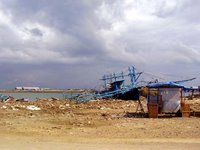 heritages (which I skipped for this time, and I know I will go back to them), but what you see in Aceh is real life at its best (and worst). So that was the end of my tourist life in Indonesia and I got my ticket to Aceh, a little concerned about what it would be like under shariyah, a little excited to see Meynar again (in the pics), a little worried if I could bare the effects of the tsunami and the earthquake...
heritages (which I skipped for this time, and I know I will go back to them), but what you see in Aceh is real life at its best (and worst). So that was the end of my tourist life in Indonesia and I got my ticket to Aceh, a little concerned about what it would be like under shariyah, a little excited to see Meynar again (in the pics), a little worried if I could bare the effects of the tsunami and the earthquake...
I wasn’t wrong. It was remarkable. I was there right after the first elections that were held in the tsunami- and conflict-hit region. The main reason of course, being Meynar, who not only allowed me to see her microfinance work there, but also gave me a great insight about the area, with our conversations as well as a tour of the projects, and landscapes. It was great to see development workers on the field, how our concepts merged and how researchers and implementers influenced one another.
If I were to part my story of Aceh into three, the main concepts would be the tsunami, the politics, and some impressions (though they are very interconnected I must admit). I can’t tell my story without these backgrounds, so I should start with the tsunami.
Aceh was the closest point of land to the epicenter of the massive 2004 Indian Ocean earthquake, which triggered a tsunami that devastated much of the western coast of the region, including part of the capital of Banda Aceh (see map). Over 200,000 people died, and over 500,000 were left homeless. This happened on a Sunday when most men and kids were at home, and women on the market. The kids couldn’t have resisted the strength of the tsunami. They were washed away with the 40m high waves. The men that died and were missing were the main wage-earner of their families, hence the social structure has been tremendously influenced. Some villages on the shore were destroyed so irreparably that the fishing communities cannot go back there, and need to find a different way of organising their livelihoods in the forests and mountains.
To demonstrate… The tsunami took a bite of this hill (“mountain” in a Dutch scale) and took it away.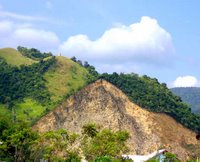
It carried this floating electricity generator (which used to be sent back and forth between islands, wherever it is needed) 20 kms inland and now cannot be removed. The wave reached as far as 40km. inland.
After the tsunami, the short-term relief work has taken a few months, but in the long term a whole economy has vanished therefore the international aid was critical. The picture of the cardboard box on the right says “Tsunami is God’s way of reminding people to help one another”. Yet, the Achenese response was not fatalist at all: Many victims who survived say that it is a new start, there’s no point in whining and should start all over again. For these people the international aid is significant as it allows them to find the means to start new businesses. Some microfinance projects seem to work very effectively in reorganising a wiped out economy. This is particularly true for less agricultural parts of Aceh.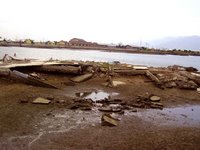
I was very impressed by two projects in particular: the mushroom project, and the village communities one. The mushroom project is a partnership between ILO and MercyCorps,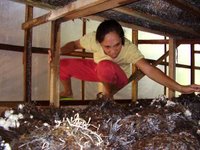 which constructed an indoor mushroom growing building for 10 women of
which constructed an indoor mushroom growing building for 10 women of a village. It takes them only a week per month to take care of the mushrooms, which are hard to find and hence quite expensive in Aceh. They are so proud and happy about their work that they want to build more of them for more women and asked Meynar’s help to apply for some funds. A few pics:
a village. It takes them only a week per month to take care of the mushrooms, which are hard to find and hence quite expensive in Aceh. They are so proud and happy about their work that they want to build more of them for more women and asked Meynar’s help to apply for some funds. A few pics: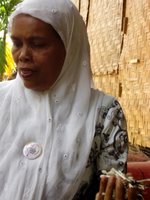
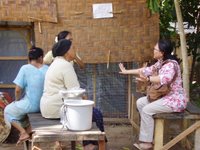
The latter is the Village Communities project that MercyCorps and WWF were doing together in which they asked the village communities how they would like to reorganise their economies, assessing the ecological and social structures as well. They said bumped into a number of problems regarding the participation of vulnerable groups, but they were constantly making an effort to ensure some deliberation all the time. The way Acehnese villages were formed (possibly related to their colonial past) seems to help: There are youth groups, women’s groups, etc. in each and every community, which they can try to strengthen.
 Did you donate for the tsunami relief? I did. I know a lot of people that did. Do have any ideas how your donation has been spent? Well, the donation I made to Red Crescent of Turkey was spent into boats that Acehnese people didn't know how to use, and to buildings they didn't bother moving into, as they were too small for Acehnese culture (and the rebuilding of a mosque around which noone lived, see pic). This is partly related to what they refer to as the spoilt market: There is so much choice for funds that most communities that have some kind of a project in mind can choose from among a number of donors. But more importantly, several people regarded the Turkish aid as very well organised and fast in the rescue missions, and quite insensible in the aftermath.
Did you donate for the tsunami relief? I did. I know a lot of people that did. Do have any ideas how your donation has been spent? Well, the donation I made to Red Crescent of Turkey was spent into boats that Acehnese people didn't know how to use, and to buildings they didn't bother moving into, as they were too small for Acehnese culture (and the rebuilding of a mosque around which noone lived, see pic). This is partly related to what they refer to as the spoilt market: There is so much choice for funds that most communities that have some kind of a project in mind can choose from among a number of donors. But more importantly, several people regarded the Turkish aid as very well organised and fast in the rescue missions, and quite insensible in the aftermath.  The Turkish village as they call it, was deserted other than some construction workers putting Turkish flags on each house (pathetic). And sadly, there were several families living in one room huts (or a combination of huts as in the pic) rather than moving into those areas which were no longer residential.
The Turkish village as they call it, was deserted other than some construction workers putting Turkish flags on each house (pathetic). And sadly, there were several families living in one room huts (or a combination of huts as in the pic) rather than moving into those areas which were no longer residential.



No comments:
Post a Comment